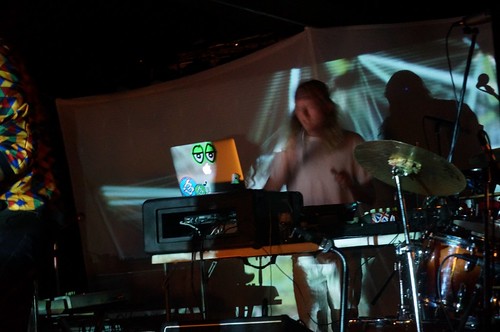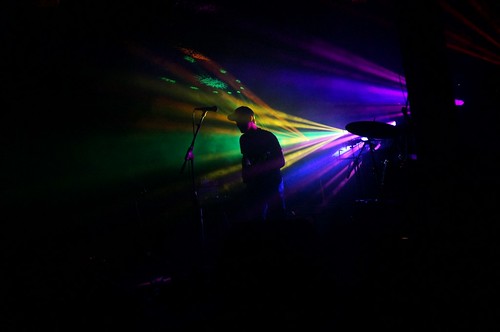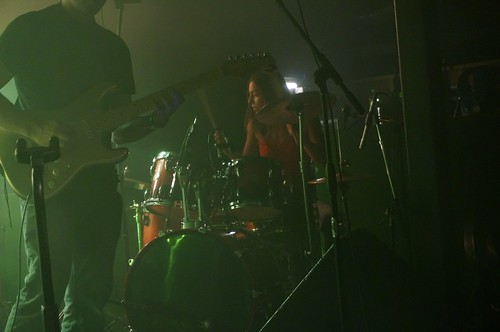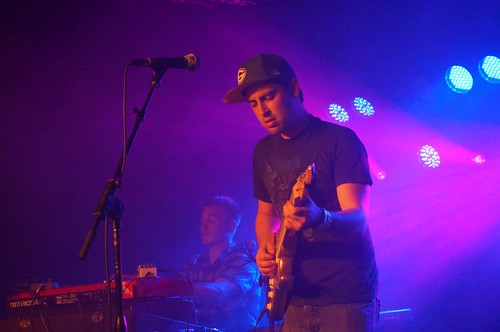Contemplate the infinite through electronica and progressive guitar shred
4.5/5.0




 It’s a short attention span musical world,where the emphasis is usually on tight pop expressions. But while mere gestures are enough to satisfy most consumers, there are still some genres that need the maneuvering room of a full album to develop their ideas. In the four years since Paper Monkeys came out, space rock stalwarts Ozric Tentacles apparently had so many inviting trails to explore that even that was too confining . Their latest release, Technicians of the Sacred, sprawls out over two full CDs. Despite the obvious excess, there's not much in the way of fluff: while the songs take their time to find their target trancelike moods, they never fall into monotony. Longtime fans will find plenty of familiar ground, but the emphasis is on electronica punctuated by Ed Wynn’s shred-tastic guitar.
It’s a short attention span musical world,where the emphasis is usually on tight pop expressions. But while mere gestures are enough to satisfy most consumers, there are still some genres that need the maneuvering room of a full album to develop their ideas. In the four years since Paper Monkeys came out, space rock stalwarts Ozric Tentacles apparently had so many inviting trails to explore that even that was too confining . Their latest release, Technicians of the Sacred, sprawls out over two full CDs. Despite the obvious excess, there's not much in the way of fluff: while the songs take their time to find their target trancelike moods, they never fall into monotony. Longtime fans will find plenty of familiar ground, but the emphasis is on electronica punctuated by Ed Wynn’s shred-tastic guitar.
Disc 1 leads off with “The High Pass”, which takes an eight and a half minute nomadic trek through many of the sonic environments that the Ozrics enjoy the most: underwater dives, expansive vistas, evocative action zones, and spelunking trips deep down into the heart of the machine. The dynamic flow accommodates both incremental transitions and freefall plunges that reset the context. The tune wanders from chill electronic grooves to mind-warpingly intense prog-rock guitar, but the anxious rhythm and pensive funk bass line remain more or less constant. The restless electro energy may form the foundation, but there are plenty of distractions that provide ear-catching details that vie for the listener's attention, from blooming synth melodies that shift and grow to a robotic interlude that would be perfect for popping.
The music that follows could be soundtrack excerpts from a randomized set of dreamscapes. The Krautrock infused “Far Memory” seems fit for an underwater world, full of echo and frequency shifted shimmers, while the electro-pop “Changa Masala” has an infectious syncopated rhythm that suggests sleepwalking through a Bollywood set as it melts away into space. The imagination can run wild in these intriguing snow-globe worlds. The band dives into each with enthusiasm and little worry for how the songs might evolve. So a cheery electronic piece like “Zingbong” might start with an uptempo New Age feel, propelled by a busy gamelan synth run and terse bass line, but the Ozrics are content to let a Zappa-esque guitar periodically warp the piece into an off-kilter jumble, knowing that they can always nonchalantly slip back into the clarity of the main riff.
The second half of the album gives freer rein to the band’s progressive rock side, with plenty of energetic guitar mutation and distortion. This disc begins with my favorite track on the album, “Epiphlioy”. The Beats Antique style world-tronica groove is built on a galloping Middle Eastern dervish rhythm that’s intricately tied to a synthesized sonic palette. Like the evocative pieces on the first CD, the song suggests a series of images: a tense chase with an undercurrent of excitement, a visit to a nomadic camp in the desert, a spaced-out psychedelic trip in the middle of an oasis. It’s easy to get lost in the drawn out narrative of the piece, but the exotic tone, along with the touchstone rhythm guitar part, provide grounding enough for the extensive 12 minute sojourn.
By the time we reach the final cut, “Zenlike Creature”, it’s been a long disorienting trip. We’re ready for the centering focus of looped interlocking patterns, but even here, the meditative flow gives way to a more progressive groove. The track see-saws from thoughtful to assertive, eventually picking up an Alan Parsons style momentum. Despite the dynamic give and take, though, there is still a kind of imperturbability at the root of the song. It's as though the band is saying, "Ignore the illusion (māyā) and just settle into the moment." The macrocosm of Technicians of the Sacred reflects this message as well. It never delivers a clear mythology or answers. Instead, it just offers a hypnotic zone to contemplate the infinite. Or not, as you see fit.
4.5/5.0





 It’s a short attention span musical world,where the emphasis is usually on tight pop expressions. But while mere gestures are enough to satisfy most consumers, there are still some genres that need the maneuvering room of a full album to develop their ideas. In the four years since Paper Monkeys came out, space rock stalwarts Ozric Tentacles apparently had so many inviting trails to explore that even that was too confining . Their latest release, Technicians of the Sacred, sprawls out over two full CDs. Despite the obvious excess, there's not much in the way of fluff: while the songs take their time to find their target trancelike moods, they never fall into monotony. Longtime fans will find plenty of familiar ground, but the emphasis is on electronica punctuated by Ed Wynn’s shred-tastic guitar.
It’s a short attention span musical world,where the emphasis is usually on tight pop expressions. But while mere gestures are enough to satisfy most consumers, there are still some genres that need the maneuvering room of a full album to develop their ideas. In the four years since Paper Monkeys came out, space rock stalwarts Ozric Tentacles apparently had so many inviting trails to explore that even that was too confining . Their latest release, Technicians of the Sacred, sprawls out over two full CDs. Despite the obvious excess, there's not much in the way of fluff: while the songs take their time to find their target trancelike moods, they never fall into monotony. Longtime fans will find plenty of familiar ground, but the emphasis is on electronica punctuated by Ed Wynn’s shred-tastic guitar.Disc 1 leads off with “The High Pass”, which takes an eight and a half minute nomadic trek through many of the sonic environments that the Ozrics enjoy the most: underwater dives, expansive vistas, evocative action zones, and spelunking trips deep down into the heart of the machine. The dynamic flow accommodates both incremental transitions and freefall plunges that reset the context. The tune wanders from chill electronic grooves to mind-warpingly intense prog-rock guitar, but the anxious rhythm and pensive funk bass line remain more or less constant. The restless electro energy may form the foundation, but there are plenty of distractions that provide ear-catching details that vie for the listener's attention, from blooming synth melodies that shift and grow to a robotic interlude that would be perfect for popping.
The music that follows could be soundtrack excerpts from a randomized set of dreamscapes. The Krautrock infused “Far Memory” seems fit for an underwater world, full of echo and frequency shifted shimmers, while the electro-pop “Changa Masala” has an infectious syncopated rhythm that suggests sleepwalking through a Bollywood set as it melts away into space. The imagination can run wild in these intriguing snow-globe worlds. The band dives into each with enthusiasm and little worry for how the songs might evolve. So a cheery electronic piece like “Zingbong” might start with an uptempo New Age feel, propelled by a busy gamelan synth run and terse bass line, but the Ozrics are content to let a Zappa-esque guitar periodically warp the piece into an off-kilter jumble, knowing that they can always nonchalantly slip back into the clarity of the main riff.
The second half of the album gives freer rein to the band’s progressive rock side, with plenty of energetic guitar mutation and distortion. This disc begins with my favorite track on the album, “Epiphlioy”. The Beats Antique style world-tronica groove is built on a galloping Middle Eastern dervish rhythm that’s intricately tied to a synthesized sonic palette. Like the evocative pieces on the first CD, the song suggests a series of images: a tense chase with an undercurrent of excitement, a visit to a nomadic camp in the desert, a spaced-out psychedelic trip in the middle of an oasis. It’s easy to get lost in the drawn out narrative of the piece, but the exotic tone, along with the touchstone rhythm guitar part, provide grounding enough for the extensive 12 minute sojourn.
By the time we reach the final cut, “Zenlike Creature”, it’s been a long disorienting trip. We’re ready for the centering focus of looped interlocking patterns, but even here, the meditative flow gives way to a more progressive groove. The track see-saws from thoughtful to assertive, eventually picking up an Alan Parsons style momentum. Despite the dynamic give and take, though, there is still a kind of imperturbability at the root of the song. It's as though the band is saying, "Ignore the illusion (māyā) and just settle into the moment." The macrocosm of Technicians of the Sacred reflects this message as well. It never delivers a clear mythology or answers. Instead, it just offers a hypnotic zone to contemplate the infinite. Or not, as you see fit.


 From skewed savants like Roky Erickson and Syd Barrett to modern mystics like Jim James and Wayne Coyne, psychedelic artists thrive out in the borderlands where the rules are flexibly vague and no one expects explanations. Beijing's
From skewed savants like Roky Erickson and Syd Barrett to modern mystics like Jim James and Wayne Coyne, psychedelic artists thrive out in the borderlands where the rules are flexibly vague and no one expects explanations. Beijing's  World music -- that vague catch-all label -- largely falls into two flavors, neither of which reflect too well on the Westerners who coined the term. The bulk of it is “delightfully exotic” or “strange but cool”, showcasing some culture’s musical heritage, but repackaged in easy to digest servings to appeal to the jaded palate. Worse than that are the half breed mutants that hover between appropriation and cargo-cult aspiration, sometimes with rock artists harnessing foreign musicians without understanding their cultural context, other times with those musicians trying with mild success to emulate Western pop. Even so, I’ll confess that I’ve enjoyed my share of all of these, sometimes with a frisson of guilt.
World music -- that vague catch-all label -- largely falls into two flavors, neither of which reflect too well on the Westerners who coined the term. The bulk of it is “delightfully exotic” or “strange but cool”, showcasing some culture’s musical heritage, but repackaged in easy to digest servings to appeal to the jaded palate. Worse than that are the half breed mutants that hover between appropriation and cargo-cult aspiration, sometimes with rock artists harnessing foreign musicians without understanding their cultural context, other times with those musicians trying with mild success to emulate Western pop. Even so, I’ll confess that I’ve enjoyed my share of all of these, sometimes with a frisson of guilt. The desert is a potent symbol. It can be unwelcoming and dangerous even as its solitude can be cleansing. In Michelangelo Antonioni’s jaundiced commentary on late 1960’s counterculture, Zabriskie Point (1970), the desert was a haven offering the possibility of a new start.
The desert is a potent symbol. It can be unwelcoming and dangerous even as its solitude can be cleansing. In Michelangelo Antonioni’s jaundiced commentary on late 1960’s counterculture, Zabriskie Point (1970), the desert was a haven offering the possibility of a new start. 
 Cosmically speaking, three and half years is the tiniest of intervals. Halley’s Comet takes around 75 years to swing by, so a three to four year pause between
Cosmically speaking, three and half years is the tiniest of intervals. Halley’s Comet takes around 75 years to swing by, so a three to four year pause between  On the one hand, it's good that
On the one hand, it's good that  Browsing through retro-inspired rock band offerings is like picking your favorite movie franchise reboot. Occasionally, an album strikes a nerve, but nothing can really replace dropping the needle on The Velvet Underground and Nico, sinking back into thrashy joy of The Pretenders, or sampling the cream of late '60s psychedelic pop bands from Northern California on a Rhino collection. It's hard for younger bands to slide in deeply enough to get past the simple surface characteristics, and those that come closest to the elusive feel rarely have enough personality to be memorable.
Browsing through retro-inspired rock band offerings is like picking your favorite movie franchise reboot. Occasionally, an album strikes a nerve, but nothing can really replace dropping the needle on The Velvet Underground and Nico, sinking back into thrashy joy of The Pretenders, or sampling the cream of late '60s psychedelic pop bands from Northern California on a Rhino collection. It's hard for younger bands to slide in deeply enough to get past the simple surface characteristics, and those that come closest to the elusive feel rarely have enough personality to be memorable.  Here’s the pitch: We’ll raise T. Rex’s Marc Bolan from the dead and partner him up with the Cramps, then polish the act to create the perfect bubblegum pop band for a Saturday morning kids’ cartoon series. Call it “So King Tuff!” What makes the act so irresistible is that Kyle Thomas,
Here’s the pitch: We’ll raise T. Rex’s Marc Bolan from the dead and partner him up with the Cramps, then polish the act to create the perfect bubblegum pop band for a Saturday morning kids’ cartoon series. Call it “So King Tuff!” What makes the act so irresistible is that Kyle Thomas,  Sometimes, it can be be excruciating to bring all the pieces together. Scattered and disjoint, they may not quite fit together into a coherent whole, but leave some out and some important facet is glossed over and missed. Fragments and Wholes, Volume 1, the latest solo project by multi-instrumentalist and producer
Sometimes, it can be be excruciating to bring all the pieces together. Scattered and disjoint, they may not quite fit together into a coherent whole, but leave some out and some important facet is glossed over and missed. Fragments and Wholes, Volume 1, the latest solo project by multi-instrumentalist and producer  Just as LSD differs from peyote, psychedelic bands each offer their own kind of trip. Syd Barrett’s earnest naïveté is worlds away from Thee Oh Sees’ sweaty swirl of garage echo and grind, and neither has much in common with the exotic sound of Dengue Fever’s Khmer-flavored surf. On Wooden Aquarium,
Just as LSD differs from peyote, psychedelic bands each offer their own kind of trip. Syd Barrett’s earnest naïveté is worlds away from Thee Oh Sees’ sweaty swirl of garage echo and grind, and neither has much in common with the exotic sound of Dengue Fever’s Khmer-flavored surf. On Wooden Aquarium,  The overused shorthand, “retro,” can mean that a group short on their own ideas has repackaged the past. Although
The overused shorthand, “retro,” can mean that a group short on their own ideas has repackaged the past. Although 









